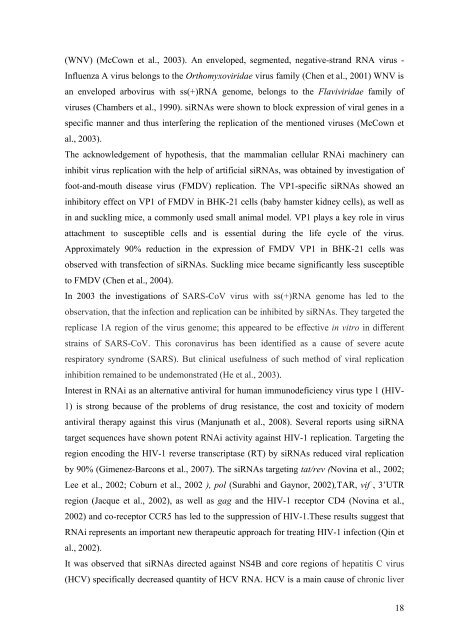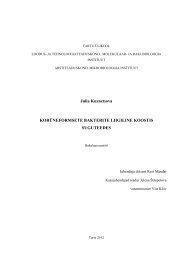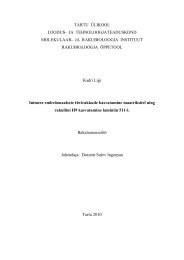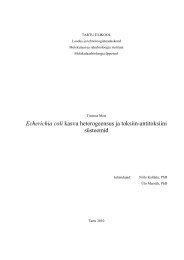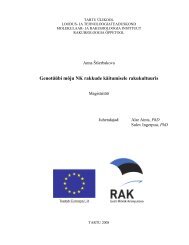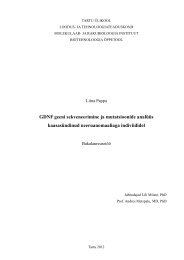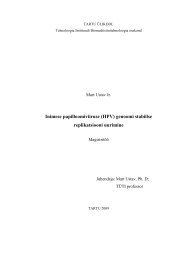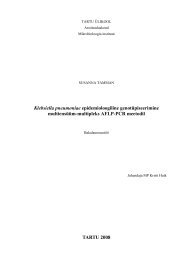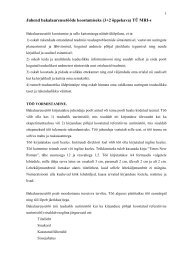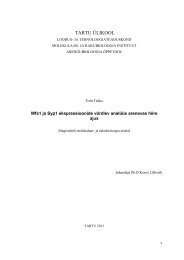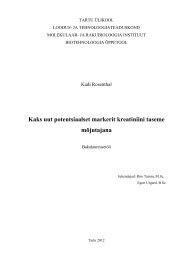Viruses and RNA interference in mammalian cells
Viruses and RNA interference in mammalian cells
Viruses and RNA interference in mammalian cells
You also want an ePaper? Increase the reach of your titles
YUMPU automatically turns print PDFs into web optimized ePapers that Google loves.
(WNV) (McCown et al., 2003). An enveloped, segmented, negative-str<strong>and</strong> <strong>RNA</strong> virus -<br />
Influenza A virus belongs to the Orthomyxoviridae virus family (Chen et al., 2001) WNV is<br />
an enveloped arbovirus with ss(+)<strong>RNA</strong> genome, belongs to the Flaviviridae family of<br />
viruses (Chambers et al., 1990). si<strong>RNA</strong>s were shown to block expression of viral genes <strong>in</strong> a<br />
specific manner <strong>and</strong> thus <strong>in</strong>terfer<strong>in</strong>g the replication of the mentioned viruses (McCown et<br />
al., 2003).<br />
The acknowledgement of hypothesis, that the <strong>mammalian</strong> cellular <strong>RNA</strong>i mach<strong>in</strong>ery can<br />
<strong>in</strong>hibit virus replication with the help of artificial si<strong>RNA</strong>s, was obta<strong>in</strong>ed by <strong>in</strong>vestigation of<br />
foot-<strong>and</strong>-mouth disease virus (FMDV) replication. The VP1-specific si<strong>RNA</strong>s showed an<br />
<strong>in</strong>hibitory effect on VP1 of FMDV <strong>in</strong> BHK-21 <strong>cells</strong> (baby hamster kidney <strong>cells</strong>), as well as<br />
<strong>in</strong> <strong>and</strong> suckl<strong>in</strong>g mice, a commonly used small animal model. VP1 plays a key role <strong>in</strong> virus<br />
attachment to susceptible <strong>cells</strong> <strong>and</strong> is essential dur<strong>in</strong>g the life cycle of the virus.<br />
Approximately 90% reduction <strong>in</strong> the expression of FMDV VP1 <strong>in</strong> BHK-21 <strong>cells</strong> was<br />
observed with transfection of si<strong>RNA</strong>s. Suckl<strong>in</strong>g mice became significantly less susceptible<br />
to FMDV (Chen et al., 2004).<br />
In 2003 the <strong>in</strong>vestigations of SARS-CoV virus with ss(+)<strong>RNA</strong> genome has led to the<br />
observation, that the <strong>in</strong>fection <strong>and</strong> replication can be <strong>in</strong>hibited by si<strong>RNA</strong>s. They targeted the<br />
replicase 1A region of the virus genome; this appeared to be effective <strong>in</strong> vitro <strong>in</strong> different<br />
stra<strong>in</strong>s of SARS-CoV. This coronavirus has been identified as a cause of severe acute<br />
respiratory syndrome (SARS). But cl<strong>in</strong>ical usefulness of such method of viral replication<br />
<strong>in</strong>hibition rema<strong>in</strong>ed to be undemonstrated (He et al., 2003).<br />
Interest <strong>in</strong> <strong>RNA</strong>i as an alternative antiviral for human immunodeficiency virus type 1 (HIV-<br />
1) is strong because of the problems of drug resistance, the cost <strong>and</strong> toxicity of modern<br />
antiviral therapy aga<strong>in</strong>st this virus (Manjunath et al., 2008). Several reports us<strong>in</strong>g si<strong>RNA</strong><br />
target sequences have shown potent <strong>RNA</strong>i activity aga<strong>in</strong>st HIV-1 replication. Target<strong>in</strong>g the<br />
region encod<strong>in</strong>g the HIV-1 reverse transcriptase (RT) by si<strong>RNA</strong>s reduced viral replication<br />
by 90% (Gimenez-Barcons et al., 2007). The si<strong>RNA</strong>s target<strong>in</strong>g tat/rev (Nov<strong>in</strong>a et al., 2002;<br />
Lee et al., 2002; Coburn et al., 2002 ), pol (Surabhi <strong>and</strong> Gaynor, 2002),TAR, vif , 3’UTR<br />
region (Jacque et al., 2002), as well as gag <strong>and</strong> the HIV-1 receptor CD4 (Nov<strong>in</strong>a et al.,<br />
2002) <strong>and</strong> co-receptor CCR5 has led to the suppression of HIV-1.These results suggest that<br />
<strong>RNA</strong>i represents an important new therapeutic approach for treat<strong>in</strong>g HIV-1 <strong>in</strong>fection (Q<strong>in</strong> et<br />
al., 2002).<br />
It was observed that si<strong>RNA</strong>s directed aga<strong>in</strong>st NS4B <strong>and</strong> core regions of hepatitis C virus<br />
(HCV) specifically decreased quantity of HCV <strong>RNA</strong>. HCV is a ma<strong>in</strong> cause of chronic liver<br />
18


